List of Authors
>>About this blog
Recent blog post
|
[Kra-san]
June 30, 2017 14:00
At Koami Shrine, "Chinowa" is set up at the Torii gate every year from June 15 to the end of the month to remove sins and filth by passing through the "Chinowa" built on the grounds of the shrine. Also known as "Chinowa Kuguri".
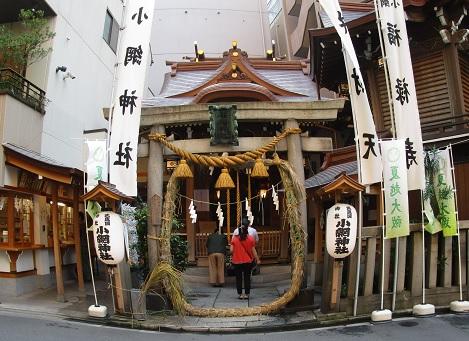
Six months later, in December, there was a similar protection against misfortune called "Nago Shinohara E" in June. "great exorcism" is a traditional event that purifies the sins and filthy in everyday life twice a year on June 30 and December 31.
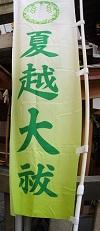  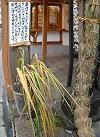
Today (June 30), I was grateful that I was able to purify the impurities of the first half of this year and spend my time safely, and prayed that I would be fine in the second half. I also took home the kaya at the entrance of my home.
1.
June 29, 2017 12:00
The architect Yoshio Taniguchi, who is currently in charge of the exterior design of GINZA SIX, writes the Nikkei Shimbun's "My Resume" every day, and I look forward to it every day, but if I read the 27th this morning, "!" I found a description and went to "confirmation" immediately.
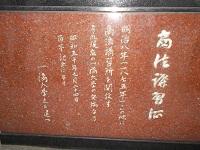 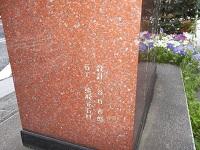
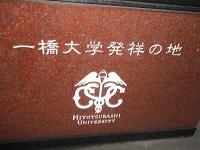 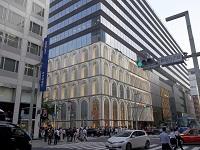
Two months have passed since the opening of the business, but the flow of people around 6-chome gives the impression that it has been quite different from before. Did you know that there is a "Code Training Center Monument" in the planting in front of the Chuo-dori of this building? It's a small rectangular shape, so it's likely to overlook it, but it's the birthplace of Hitotsubashi University with a black stone roof on a red stone. We know that "1875 (1895) Arinori Mori opened as a private school was repeatedly renamed and reorganized, and Hitotsubashi University was established in 1949 (1949)" (Shimonoshiri Encyclopedia, Chuo-ku). It will be that many. I knew that there was a "Code Training Center Monument" on the front and "Hitotsubashi University Birthplace" on the side facing the road, but this time I confirmed the side. There was!
It's "Design Yoshiro Taniguchi". Yoshiro Taniguchi is the father of Yoshio Taniguchi, a professor at Tokyo Institute of Technology who is famous for designing the Higashimiya Imperial Palace, the Tokyo Museum of Modern Art, Meiji Village, and others. Yoshio Taniguchi is written as follows. "About 10 years ago when I started working on the design of GINZA SIX, I noticed something walking along Chuo-dori. The name of my father was engraved as the designer of the monument. I was really surprised when I discovered the smallest architecture in Ginza in front of Ginza's largest architecture that started designing," a family of a Chinese tourist was taking a commemorative photo in front of the monument. It's a bit fun to say, "The big and small works of the architect's father and child are lined up on the street."
"Code Training Center Monument" faces Ginza 6-10 Chuo-dori.
[Shiba Inu]
June 28, 2017 14:00
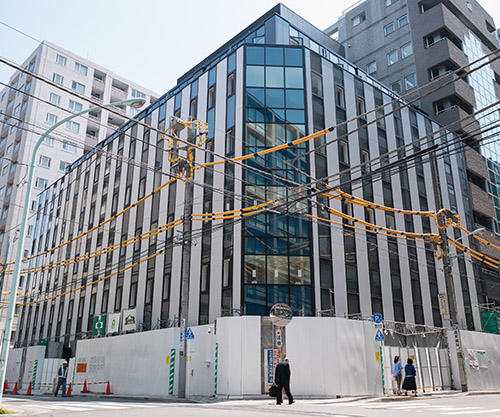
The Nihonbashi Tax Office has been under construction for a long time, but now it looks like this! It is a building that is moderately modern and has a Japanese taste. It will be completed in August and will start operations on September 19. The first floor will be a parking lot for users. The shops in the building, which the local residents had expected little....There's nothing in particular! I'm sorry!
New commercial buildings are being built one after another in Ginza, and by the time autumn begins, the scenery of Ueno-Okachimachi neighborhood changes. The redevelopment of the city, such as the development of the subway station premises, will continue for the Olympics, but the residential areas in Chuo-ku have also changed accordingly. I would like to leave the scene of Chuo-ku in Heisei on this blog as much as possible.
[Shubo's Ten Hands]
June 24, 2017 18:00
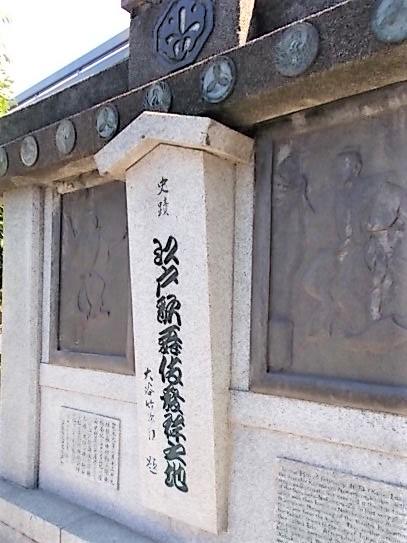  The birthplace of Edo Kabuki, the site of the Kyobashi Daikon Riverside Vegetable Market The birthplace of Edo Kabuki, the site of the Kyobashi Daikon Riverside Vegetable Market
This is 3-4 Kyobashi, Chuo-ku.
The two stone monuments are in the same place.
It was erected in 1957 as the birthplace of Kabuki.
It was in 1624 that Nakamuraza was allowed to play a drum tower in the southern part of Nakahashi. Since then, it has continued for 270 years until 1893. At that time, it was a very lively place with huts such as puppet manipulation and Joruri. After that, the industrial goods were removed for reasons close to Edo Castle and moved to Nihonbashi Horidome-cho.
The stone monument at the site of the Seimono Market was erected in 1959 in retrospective of the opening of the market for 280 years.
The market was located in Kitazume, Kyobashi River, which has good water transportation. The name of the radish is given because the large number of radishes arrived. It has nothing to do with the birthplace of Kabuki.  I hope you'll be sure. I hope you'll be sure.
After that, it was merged with Tsukiji Central Wholesale Market in 1935 and moved to.
Please take a look while shopping in Ginza.
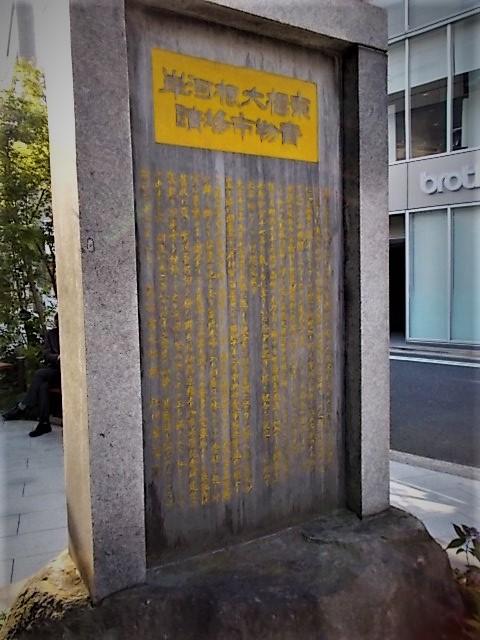
[Shubo's Ten Hands]
June 23, 2017 09:00
 Shinroku Hazama Peace pagoda Shinroku Hazama Peace pagoda
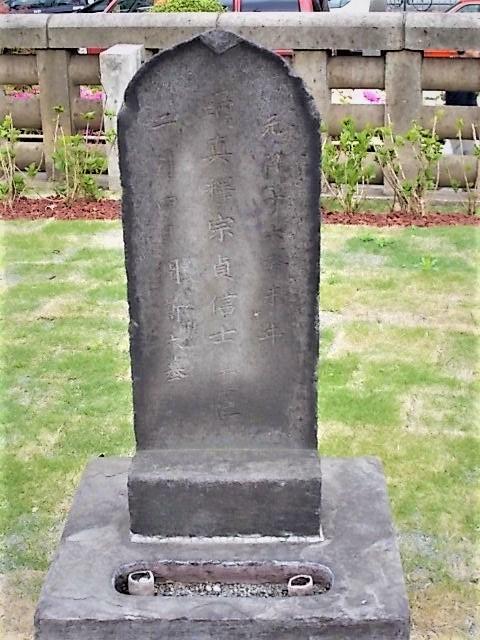  Chushingura, which is always broadcast every year at dusk. Chushingura, which is always broadcast every year at dusk.  
He joined the enemy of Takumi Asanouchi with his father and brother (it is said to have given the first spear to Kira Uenosuke).
 In the defeat of Kira's house, he belonged to the back gate squad and cut off at Mori's house with each other. In the defeat of Kira's house, he belonged to the back gate squad and cut off at Mori's house with each other.  
The remains were buried in his own Tsukiji Honganji, Bodaiji Temple, by his son-in-law Nakado Matasuke.
 Naturally, there are different tombstones at "Honganji alone" and "Sengakuji sleeping with each other". Naturally, there are different tombstones at "Honganji alone" and "Sengakuji sleeping with each other".  
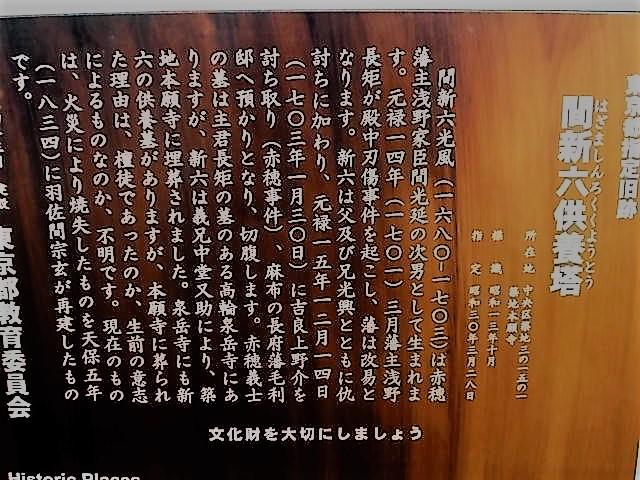 It is a tradition, but after the defeat, there is a story in which one's spear and Kaneko of the memorial service were connected and thrown into the precincts at the time of withdrawal. It is a tradition, but after the defeat, there is a story in which one's spear and Kaneko of the memorial service were connected and thrown into the precincts at the time of withdrawal.
It seems that "Shinroku no Red Spear" still remains as a temple treasure. (Not available)
It's right next to Tsukiji Market. Please drop in on your way home from shopping.
[O'age]
June 23, 2017 09:00
Ichiishibashi (1-11 Yaesu)
According to the explanation board of the local Chuo-ku Board of Education (Chuo inhabitant's cultural property, lower left photo), the name of the bridge is derived from Shosaburo Goto, who uses the shogunate Koza in Honryoka-cho north of the bridge, and Gofukumachi south of the bridge. There is a mansion of Goto Seidensuke, a kimono shop, and it is named Goto, Goto + Goto. If there is an objection to this, it is also introduced in "Chuo-ku Monoshiri Encyclopedia" as follows. It is derived from the fact that this bridge was replaced with one rice stone in accordance with the Eiraku Zen sentence, which was banned in use in the early Edo period.
 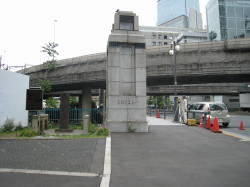
In addition, Minami-Hashizume has a "Ichiishibashi Lost Shirase Stone Mark" (Designated Cultural Property, Tokyo), which seems to have been crowded with many people during the Edo period. When I got lost, my parents and children sometimes lived apart for a lifetime. This stone marker is the only one from the Edo period and is regarded as a valuable historical material.
In addition, the largest skyscraper in Japan has been planned on the west side since 2020, and the demolition of existing buildings is underway. I think it will become an area that attracts the attention of many people.
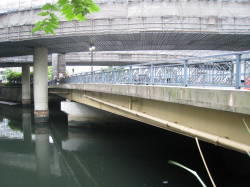 The highway passes through the upper part, and the lower part of Ichiishi Bridge is low from the water surface. The highway passes through the upper part, and the lower part of Ichiishi Bridge is low from the water surface.
Ichiishibashi, whose name is Yamibashi, is also introduced in Edo famous places such as Edo famous places. It is said that he could see eight bridges, including himself, from this Hashigami. Now Dosanbori and outer moat are buried, and the remaining four are Jobanbashi (under demolition and renovation), Ichiishibashi, Edobashi, and Nihonbashi. Dosan Bridge, Zenbe Bridge, Kaji Bridge, and Gofuku Bridge have no actual bridge, but there are some places where explanation boards are installed.
The photo on the lower left, the north side of Jobanbashi. The old Joban Bridge, which is under renovation work, is hidden by Tokiwa Bridge and cannot be seen. The photo on the right shows the Nihonbashi direction, the bridge girder of the expressway, etc. Edobashi is not visible, but Nihonbashi seems to be a little bit like that.
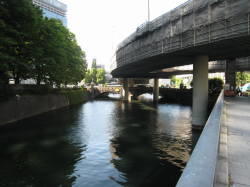 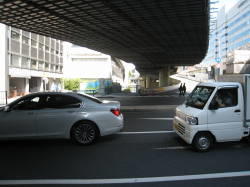
The lower left is the site of Dosan Bridge, and the lower right photo shows the site of Gofuku Bridge.
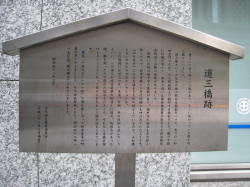 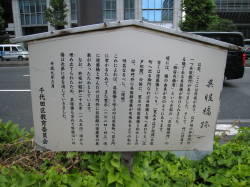
The photo below shows the explanation board of the blacksmith bridge.
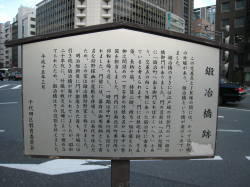
|
Links
|






